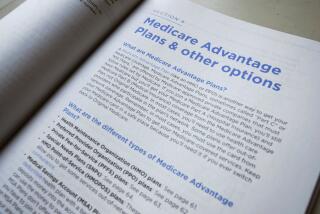What the history of Medicare Part D can tell us about Obamacare

- Share via
How Americans will take to the Affordable Care Act over the long haul may be hard to predict, but mapping out its future course need not be entirely the product of guesswork. That’s because we have a model on which to base our predictions: Medicare Part D, the prescription drug benefit enacted just over 10 years ago.
That’s the conclusion of an article in the latest New England Journal of Medicine by Julie M. Donohue, a health policy expert at the University of Pittsburgh. Her main message: gaining public acceptance for a major program takes time.
“It takes a couple of years at least for people who are eligible for coverage to become aware of a program, to enroll in that program and to experience the benefits,” Donohue says in a taped interview accompanying the article. “And until people experience the benefits of an insurance program, especially something that’s new and a little different, the public opinion of that program may be relatively low.”
Donohue refers us back to the rollout of Part D, which began on Jan. 1, 2006, with “poor communication with beneficiaries, computer glitches, complicated plan choices and cost concerns” -- all familiar features of the Obamacare implementation.
One question was whether people would enroll; in the first year, just over 50% of Medicare enrollees opted for prescription coverage, despite a system that raised premiums considerably for those who delayed. By 2013, the enrollment rate was 69%; many seniors still obtain their prescriptions through other sources, including retiree benefits from their former employers. But 10% of Medicare members still lack coverage, Donohue says, which is more than planners expected. (See accompanying graph.)
Another issue shared by Part D and the ACA is consumer confusion at the multitude of choices. Enrollees had to figure out how to balance premium costs against formularies--that is, whether their current medications were covered by a plan option and at what level of co-pay or other cost-sharing.
To this day, “most don’t take all of these different bits of information into account when they’re making their choice,” Donohue says. Medicare provided a plan-finder tool online to help beneficiaries judge among options, but it wasn’t widely used.
That parallels the confusion faced by ACA enrollees, many of whom also may be navigating the interactions of premiums, deductibles and network choices for the first time. “Really understanding the complete picture of a benefit and cost-sharing is difficult to do,” Donohue observes.
Medicare officials are still tweaking the prescription program, looking for the right balance of efficiency and selection, she reports--that is, imposing limits on some drugs in the interest of lower costs. Medicare established drug-choice standards by requiring plans to cover all drug in six classes, including antiretrovirals (such as HIV drugs), anticonvulsants (for seizures) and antidepressants.
More recently they attempted to liberalize those rules to give plans “more leverage in price negotiations” with manufacturers, Donohue says. But drugmakers, doctors and hospitals, and patients objected, and the change was dropped.
That shows how new programs create their own constituencies with an interest in the new status quo. For the ACA, that could be good news and bad news: it will build public resistance to cutbacks or repeal of the law, but may also hamper efforts to make it more efficient. “Because the ACA’s impact on the health sector is even more far-reaching than Part D’s,” Donohue writes, “one can expect even greater resistance to changes to essential benefits or the generosity of coverage.”
The main lesson? “You can’t necessarily generalize from the first year of a program to subsequent years,” Donohue says in the NEJM interview. “There was a lot of confusion about Part D when it was first set up, there were concerns that this new market wouldn’t work, that people wouldn’t know enough to be able to navigate the market, and they wouldn’t sign up for coverage.”
In sum, she says, “The headlines about Part D in 2005 and 2006 sounded an awful lot like the headlines in late 2013 and 2014 about the ACA.”
Keep up to date with The Economy Hub by following @hiltzikm.
More to Read
Inside the business of entertainment
The Wide Shot brings you news, analysis and insights on everything from streaming wars to production — and what it all means for the future.
You may occasionally receive promotional content from the Los Angeles Times.











